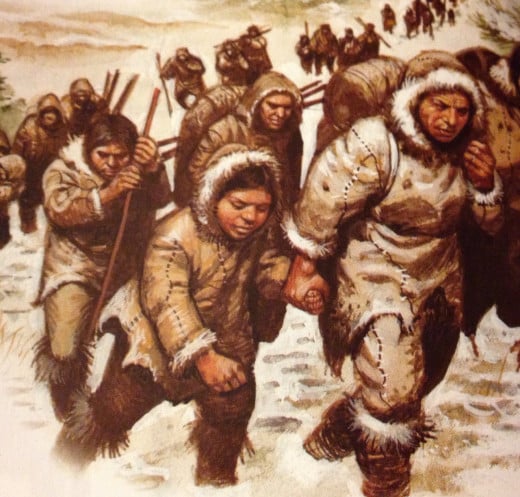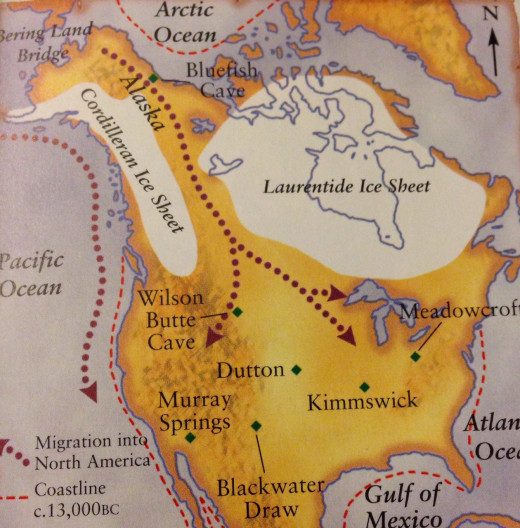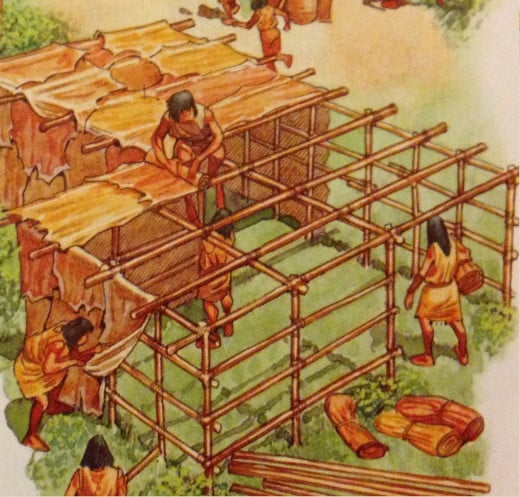The Early Americans

How did they arrive?
It is thought that the first North Americans came from the north tip of Asia (between 15,000 and 12,000 years ago), which is now known as Siberia. During the Ice Age, the two continents where linked by ice sheets known as the Bering Land Bridge, which the early Americans walked across. It was created between Siberia and Alaska due to the sea level being about 100 meters lower than it is today. Some people may have also arrived on boats and rafts, stopping often along the Cordilleran Ice Sheet. No one knows why they decided to make this journey, but it is suggested that the harsh Ice Age conditions convinced them to look for a warmer and more comfortable place.
When they reached Alaska, they were well prepared for the weather because the climate in Siberia was similar to that of North America. However, many moved south in search of better weather and food (there was little vegetation in Alaska, so most of their food came from hunting and fishing).


How do we know they came from Siberia?
One clue is the way the early Americans made their tools and weapons – chipping tiny flint blades from bigger lumps of stone, jamming them into grooves along the edge of a piece of bone to make a spearhead. Spearheads with the same design have been found in both Siberia and North America. They are known as Clovis points, named after the city where the tools were found, and their makers the Clovis people.
As the ice melted the animals they hunted with their spears became extinct, and the Clovis people vanished as the environments of North America changed, developing from vast woodlands to arid deserts.
What about South America?
In South America there is evidence of human settlement by 12,000 years ago, such as the cremated remains of humans in the caves of Monte Verde, Chile. This site also contains remains of huts and homes of the early South Americans, constructed with wooden frames and animal skins.
However, at Pedra Furada Rock Shelter in Brazil, there are areas of painted rock which scientists date to around 32,000 years ago. Not all agree with this dating, but if it is correct, it's likely that settlement also began much earlier in North America, but the people left no surviving remains.


The End of the Ice Age
As expected, at the end of the Ice Age there was a massive change in the world’s climate. In most places the ice melted and made the sea level rise, causing great floods in flat areas around the sea. The land bridge between Siberia and Alaska disappeared, cutting off North America from Asia.
The way of life changed, and people developed new methods of hunting and fishing. These techniques were more efficient that the previous ones, which meant that the people didn’t have to move around so much. They set up camps where food was plentiful and where they could mine flint to make tools and weapons.
Most settlements in this period were by rivers or the sea where people could rely on great food supply and transport. The rivers provided an efficient way to travel through the dense forests, paddling in dug out canoes and exchanging valuable goods such as flint tools or furs with other travellers they met on the way. They were the highways of the Stone Age.
This new lifestyle meant that the people were better fed, more comfortable and better settled than their ancestors, leaving them more time to develop advanced tools and skills.
As a result, their children began to survive to become adults, leading the total numbers of people to rise and pushing the population to spread.
Exploring America
People were suddenly much freer to go where they wanted in search of food and raw materials. They found a range of different regions such as the Great Plains and the drier areas of the southwest.
At first they moved south, following the mammals and hunting them with their spears. They also spread east and west to find sources of flint for their tools. Archaeologists have traced many of the stone tools to find that some were carried hundreds and thousands of kilometers, showing how far the hunters traveled.


Settling Down
It took several thousands of years for the climate to settle down into a pattern that still exists today. As this happened, creatures like mammoths became extinct and humans turned to small animals for food. They also developed lighter and more accurate spears, hunting game without the need to ambush it first.
On the grasslands there were still large creature such as bison, which provided people with more products like meat to eat and hides to make leather. From around 9000BC, a more settled lifestyle began to evolve, and at around 3500BC, the people of North America started to live in permanent villages.









